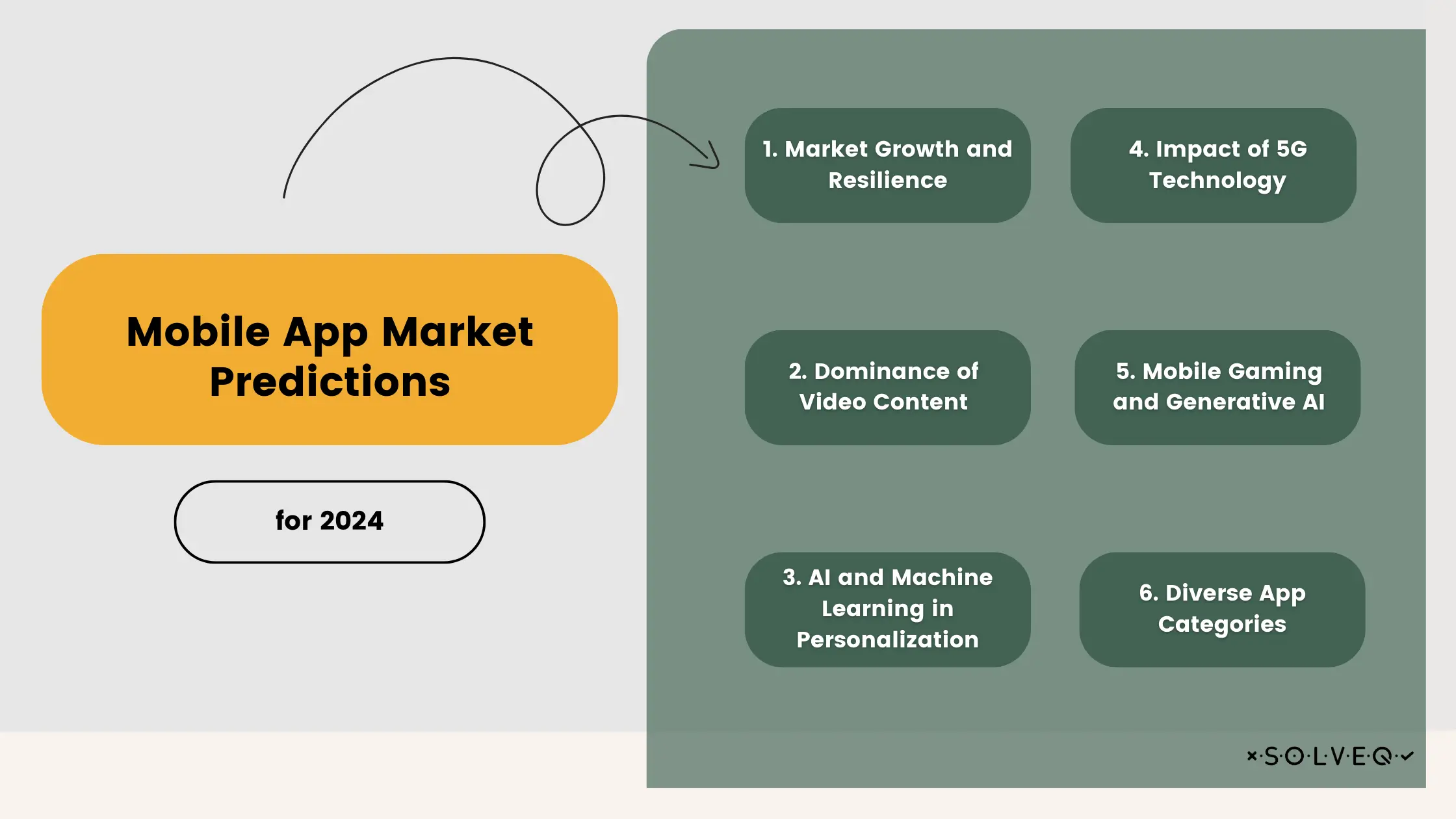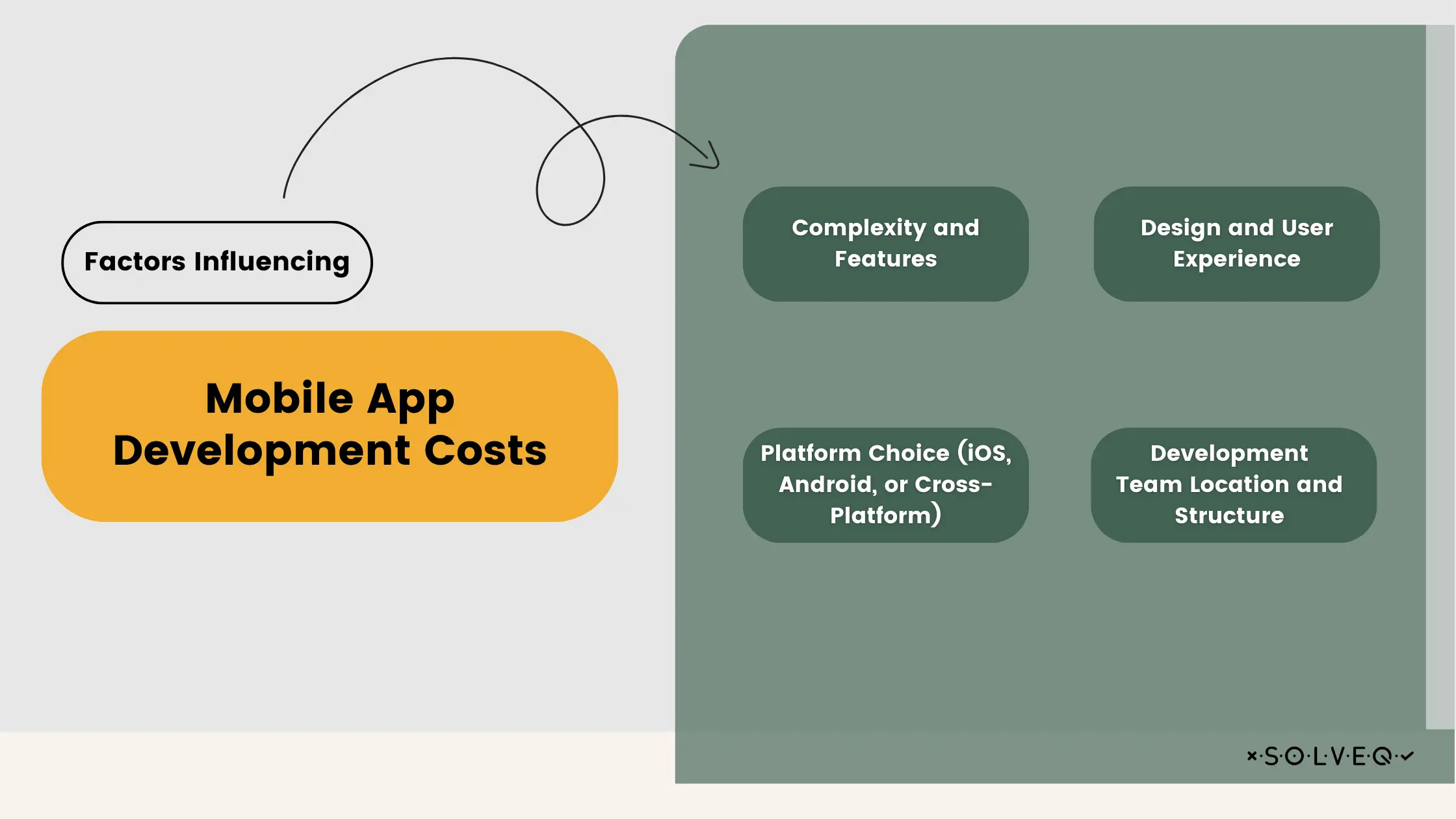What Determines the Price of Developing a Mobile App? 2024 Edition
8 Feb 2024 • 13 min read

Eryk Libelt

In the digital age, mobile apps are central to tech progress and user engagement. As mobile tech grows, knowing mobile app development is key for success in this field. This article focuses on crucial elements of mobile app development in 2024, including market trends, cost factors, and effective development strategies. Understanding these essentials is vital for success in the ever-evolving, competitive world of mobile applications.
Mobile App Market Predictions for 2024
As we delve into the dynamic and ever-evolving world of mobile applications in 2024, it's crucial to understand the underlying trends and predictions shaping this lucrative market.

1. Market Growth and Resilience
The mobile app economy has demonstrated robust growth and resilience, now valued at a half-a-trillion-dollar market. Consumer spending on mobile apps reached $171 billion, with an 11% year-over-year increase in 2023. The total mobile ad spend hit $362 billion, indicating an 8% year-over-year rise. This growth is driven largely by apps, outpacing games in consumer spending.
2. Dominance of Video Content
Video content continues to be a major force in mobile marketing. It is predicted that mobile video will constitute a significant portion of global mobile data traffic. Short-form videos, live streaming, and interactive video ads are increasingly important for capturing audience attention, with platforms like TikTok influencing trends.
3. AI and Machine Learning in Personalization
Advanced AI and ML technologies are expected to revolutionize personalization in mobile apps. These technologies can analyze user behavior and preferences to deliver highly personalized content and recommendations, enhancing user experience and engagement.
4. Impact of 5G Technology
The rollout of 5G is set to transform mobile experiences with faster speeds and improved connectivity. This advancement will enable richer multimedia content and smoother augmented reality experiences, thereby enhancing overall user experience.
5. Mobile Gaming and Generative AI
Despite a downturn in 2022, mobile gaming is showing signs of recovery, especially in markets outside China. Additionally, Generative AI is experiencing explosive growth, significantly impacting the mobile app market, including sectors like AI chatbots and art generators.
6. Diverse App Categories
Various app categories are witnessing growth, with sectors like entertainment, social media, health and fitness, and retail/e-commerce gaining traction. This diversity is a reflection of the evolving consumer preferences and technological advancements shaping the app market.
These trends underscore the dynamic nature of the mobile app market in 2024, highlighting the importance of staying abreast of technological advancements and consumer preferences to succeed in this rapidly evolving landscape.
Factors Influencing Mobile App Development Costs
Transitioning from the broader market trends, let's focus on the specific elements that directly impact the cost of mobile app development. Here are several key aspects that come to the forefront:

1. Complexity and Features
The complexity of an app and the features it includes significantly impact development costs. Basic apps with fundamental functionalities are less expensive compared to those that incorporate advanced features like AI, machine learning, or complex backend integrations. The cost escalates as the complexity increases, with simple applications requiring less development time and resources compared to complex ones.
2. Platform Choice (iOS, Android, or Cross-Platform)
The choice of platform (iOS, Android, or cross-platform development) also plays a significant role in cost determination. Developing for different platforms has varied cost implications due to the specifics of each platform. Cross-platform solutions might offer cost savings while targeting multiple platforms.
3. Design and User Experience
The UI/UX design is crucial in app development, and custom designs can elevate costs. Investing in a good design ensures a better user experience but adds to the budget. This includes aspects like wireframing, mockups, user testing, and the integration of UI animations and graphics.
4. Development Team Location and Structure
The cost varies significantly depending on the location and structure of the development team. Hiring a team from North America or Western Europe might be more expensive compared to teams from regions like Asia. Additionally, the choice between working with freelancers, in-house teams, or outsourcing agencies affects the overall cost. Outsourcing can often be a more budget-friendly option, offering access to a diverse range of skills and expertise.
Other important factors to consider include:
- Testing and Quality Assurance: Extensive testing and QA are required for more complex apps, which can increase development costs. However, skimping on this phase can lead to bugs and poor user reviews, which can be more costly in the long run.
- Backend Infrastructure and Integration: The cost is also influenced by the backend infrastructure, including servers, databases, APIs, and data storage solutions. Integration with existing systems or third-party services adds to the complexity and cost.
- Security and Compliance: Ensuring that the app complies with data privacy regulations and security standards is essential and can prevent costly legal and reputational issues later on.
- Maintenance and Updates: Post-launch, the app will require ongoing maintenance, updates, and possibly scaling, which should be factored into the budget.
- Specific Requirements and Geographic Location: The specific requirements of the project and the geographic location of the development team can significantly impact the costs. For instance, integrating multi-language support or catering to specific device orientations can increase the budget.
Understanding these factors can help in making informed decisions and effectively managing the budget for mobile app development in 2024.
Ways to Save Money on Mobile App Development
After exploring the dynamic trends and cost factors in mobile app development, it's equally crucial to understand how to strategically navigate these costs. Effective strategies you may find useful are:
Choosing the Right Development Approach
When it comes to development approaches, considering hybrid platforms can be cost-effective, especially for apps requiring less platform-specific functionality. Hybrid apps offer cross-functionality and are easier and less expensive to develop, albeit with some limitations in terms of platform capabilities. This approach is suitable if you are looking for a simpler app that doesn't require extensive native features.
Optimizing Team Structure
The structure of your development team can greatly influence costs. In-house development can be less expensive as it utilizes existing resources, but may lack certain skills. Hiring freelancers for specific tasks can be cost-efficient, though it might affect the commitment and quality. Engaging an app development agency, while financially demanding, can offer comprehensive expertise and quality results.
Leveraging Open Source Tools and Frameworks
Using open source tools and frameworks is a smart way to reduce costs associated with licensing and development tools. This strategy not only saves money but also allows for tapping into a wealth of community-driven resources and support.
Prioritizing Core Features with MVP Approach
Starting with a Minimum Viable Product (MVP) that includes only core features can significantly reduce initial investment. This approach allows you to test the market with a basic yet functional version of your app, gather user feedback, and iteratively improve the app, ensuring that you invest in features that your users truly need.
Implementing CI/CD and Agile Methodologies
Implementing continuous integration (CI) and continuous delivery (CD) can streamline and automate your development processes, enhancing efficiency and reducing time and cost. Pairing CI/CD with Agile methodologies can further optimize your development process, leading to faster delivery and improved quality, thereby saving time and costs in the long run.
Regular Check-Ins and Milestones
Regular check-ins and setting clear milestones are crucial for keeping the development process on track and within budget. This approach helps in managing the project efficiently and ensures that the development aligns with the agreed-upon goals and timelines.
Utilizing Third-Party APIs
Integrating third-party APIs for common functionalities like maps, weather widgets, or payment gateways can save significant development time and cost. This approach allows you to leverage existing, proven solutions instead of building these components from scratch.
Effective Bug Fixing and Software Testing Automation
Proactive bug fixing and automated software testing can prevent costly reworks. Detecting and addressing issues early in the development process is less expensive and more efficient than fixing them later.
Simple and Effective Design Solutions
Opting for simple but effective design solutions can also save costs. Complex designs or custom animations can extend the development process and increase expenses. A well-thought-out simple design can be both cost-effective and appealing.
Reusing Components
Reusing components in app development can save time and money. Many mobile apps share similar foundational elements, and leveraging these reusable components can significantly reduce development time while still allowing for customization.
Implementing these strategies can help in optimizing the budget and reducing the overall cost of mobile app development in 2024, ensuring a balance between cost-efficiency and quality.
Types of Pricing Models
Navigating the financial aspects of mobile app development requires not just understanding the costs but also choosing the right pricing model. This section is crucial for anyone involved in app development, as it can greatly impact both the budget and the project's overall success. Let's dive into the various pricing models available, exploring their unique characteristics and suitability for different types of projects. Whether you're a startup owner, an investor, or a developer, understanding these models will empower you to make informed decisions that align with your project's objectives, budget constraints, and long-term goals.

- Fixed Price Contracts: Ideal for projects with a well-defined scope and timeline, offering budget predictability but limited scope flexibility.
- Time and Materials (T&M): Offers flexibility for evolving requirements, but requires vigilant budget monitoring.
- Retainer Model: Suitable for ongoing projects needing continuous maintenance or updates, providing a fixed number of hours for a set fee each month.
- Equity or Revenue Sharing Models: A high-risk, high-reward model tying payment to the app's future success, suitable for startups and investors.
- Hybrid Models: Combines elements of different models to suit various project phases, balancing budget predictability and flexibility.
Understanding these pricing models will help in effectively managing the financial aspect of your mobile app development project.
Summary
Delving into the pivotal trends and strategic approaches of mobile app development in 2024, this article unpacks the complexities of cost factors and the versatility of pricing models. These insights are vital for navigating the ever-evolving mobile app landscape. Embracing these key findings could be the difference in thriving within the dynamic world of app development. Interested in leveraging cross-platform app solutions? Reach out to explore how these trends can be applied to your mobile app endeavors.
Share:
Looking for expert development team?
Schedule a call with Tech Consultant
